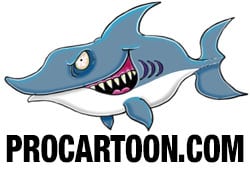Digital Artist John Leben – Artistic Freedom, Success and No Boss!
While trawling the net I stumbled upon a digital artist whose work intrigued me. I have recently published a childrens book ‘Andorra’s Box‘ on Amazon Kindle and the story is set on a magical land which floats in the sky.
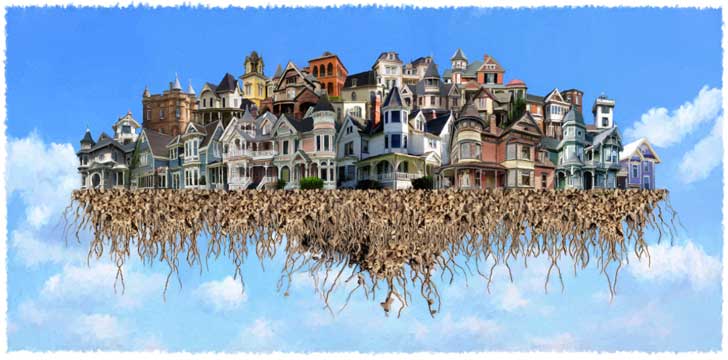
The images I was looking at on the Artsy Shark web site were very much like the imaginary land I had written about. I started to dig deeper into the superb work of digital artist John Leben.
John, who comes from the south west side of Chicago, produces fascinating artwork in his Urban Punk theme that he describes as ‘surrealistic imagery, fantasy, and, yes, humor to show a world of inept leadership and absurd solutions to environmental problems’ . The style of the theme is a mix of of photographic, cartoon and surreal images that is created in digital format to produce evocotive and extremely eye catching art.
I contacted John in late March 2017 and he kindly gave up some of his valuable time to discuss his career, development and artistic styles. He also provides a real insight into the world of art fairs where he displays and sells his artwork.
It’s a fascinating story with a very happy outcome that most artists can only dream of – being able to say goodbye to a boss and being able to make a good living purely from art.
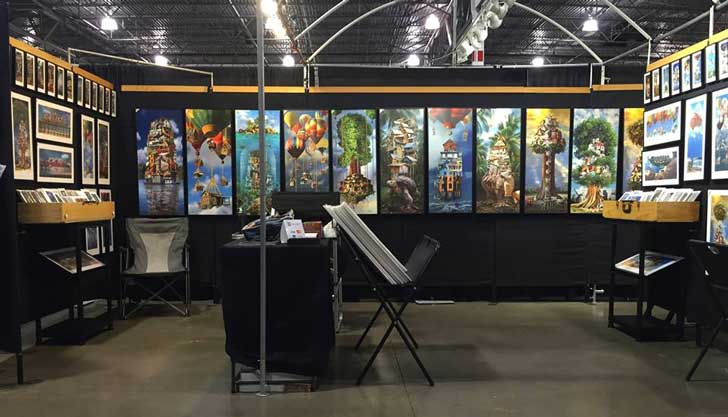
You were in 8th grade when you started formal art training – was there someone in your family who is artistically talented that pushed you in this direction or was it just an inner ambition?
My mother dabbled with painting, but no professionals in the family. I guess I just liked the idea of being an artist.
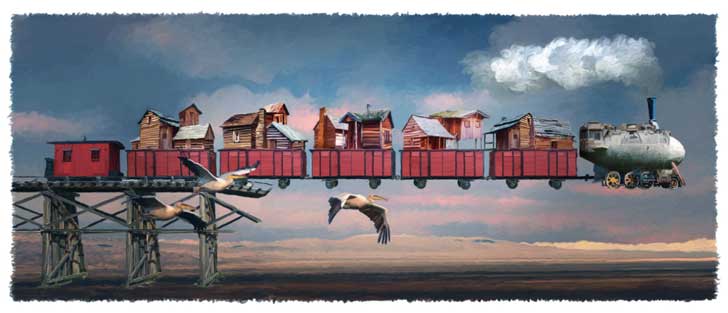
You were dedicated to art at quite an early age as a result of study at the Art Institute of Chicago. What was it that really hooked you into a lifetime ambition to become a professional artist and who inspired you along your academic journey?
I think it was the lifestyle that pushed me into the art business. Even in my work as a filmmaker and media producer, I liked the idea of working for myself rather than having a job. As a media producer I produced many media “products” that I had hoped would generate enough income through people buying videos that I had produced. Although I made a good income producing programming for clients, each of those clients was my “boss.” With my independent programming, I hoped to be completely free to do my own thing and not have any other person tell me how to do it.
After I closed down Leben Productions, my media company, I transitioned into my first love… fine art. Now, at last, I could paint what I wanted and hope that it would find an audience big enough to help me make a living. I would put my art out there and show it to people and if they liked it, they would buy it. That appealed to me. Nobody was telling me what to paint. I painted what I wanted. Sometimes it would sell. Sometimes it wouldn’t.
You won a scholarship to go to Europe for 6 weeks – where did you go, what did you see and what did you get out of this fabulous award?
My wife, Marcia and I travelled around… mostly on trains. We did Amsterdam, London, Paris, Rome, Florence, Munich, Barcelona and some time on the beaches of Spain. We went to lots of churches and museums and we experienced cultures that were different from what we knew in the U.S. It was a terrific trip. We came home without a penny in our pockets.
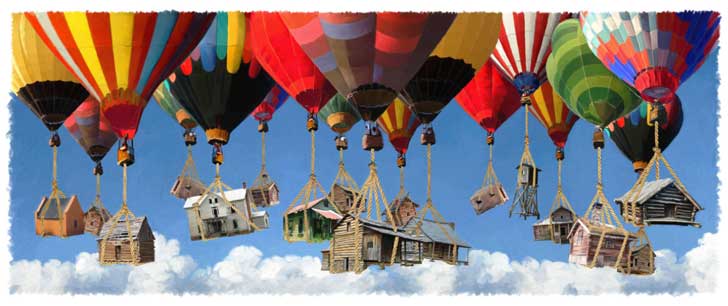
In some of your earlier work you utilized Xerox technology for developing images with a theme of degeneration caused by the involvement of technology. Could you explain this process and how did you discover it?
Technology has a fascination for me, both as a medium for producing art, and as a subject for my art. I also have a love/hate relationship with technology. I’ve seen changing technologies wreak havoc on many people and their occupations.
One summer job I had as a student was to work in a commercial artist’s studio. I worked on a catalog. Each page was created using pieces of type and pieces of pictures, all pasted up into a layout that was photographed for the printing plate. There were “paste-up” specialists, photographers and illustrators working in the studio.
All of them struggled to adapt when the computer became the medium for creating a layout. The same thing happened to filmmakers when video became a prominent tool, then interactive computers took over from video. Video producers who invested hundreds of thousands of dollars in high tech video production gear got severely burned when their younger competitors learned to do the same thing using a hand held camera and a Macintosh computer. Technology is wonderful, but it is also terribly disrupting.
Anyway… Xerography. I used it to help me create abstractions of pictures I was working on. I learned that a xerox copy would slightly distort its copy. So, I xeroxed a picture, than xeroxed the copy, then xeroxed the copy of that. I went for, sometimes 100 generations until the final copy was unrecognizable from the original. I did books showing this degradation, and I projected some of these xerox abstractions onto canvas and painted them.
My MFA graduate thesis at the Art Institute was on xerography. I actually wrote a 30 page paper on the process and its implications. The paper was part of an exhibit at the Art Institute. Page one was completely readable, but by the time you got to the end, the letters were so abstracted by the xerox process, that they were no longer readable. I also made several paintings of the pages of this book.

After graduation I created a series called “My Brother’s Robot.” I had a big gallery show at a Chicago gallery in the 70s. I drew a series of pen and ink pictures of a robot my brother created for a science fare. then I used xerox technology to abstract the pictures. I made paintings of many of these abstractions.
I fell in love and got married around this time. My wife worked as a teacher and supported me as I created my work and tried to sell it. Eventually I took a job as an art director for a company that produced training products for the computer industry using a brand new medium at that time: video. One thing led to another, two daughters were born, and my art took a back seat to supporting my family.
Your current paintings have a photographic come cartoon come surreal mix which blends perfectly. How did you evolve into this style?
When I decided (finally) to create a business out of my passion (art), I decided that printmaking would play a big part. I painted large canvases with acrylics, and I sold some, but the financial payback was not sustainable. If I spend a month on a painting, I’d have to sell it for a ton to make a profit and to support my career.
My first use of the computer as an art medium was really for reproduction, not creation. I did a series of pen and ink drawings on paper. I scanned them into my computer at high resolution, then made limited edition prints using an inkjet printer in several sizes. I could spend a week or more making a good drawing, then sell prints for a reasonable amount.
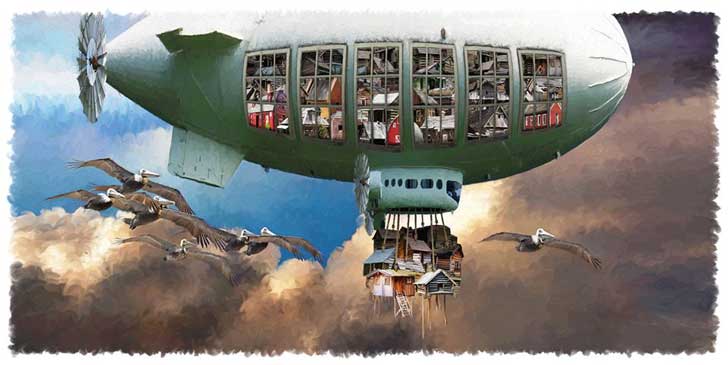
Next, I thought, why not eliminate the middleman? I started drawing the pictures directly into the computer using a thin paintbrush tool in Photoshop. They had a completely different look than a drawing made on paper. Lines were a bit shaky and the pictures looked more abstract.
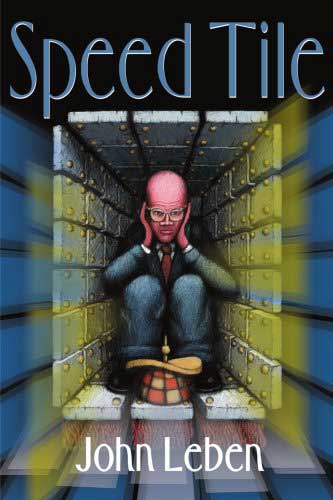 Next I started using Photoshop with colors, creating more surrealistic images. I created an imaginary element called a “speed tile” that took off as a symbol for technology and wound up a prevalent stylistic element in all my pictures. The mythology of speed tiles was that they were left behind in the sand dunes along Lake Michigan’s shores by an ancient civilization. They had addictive properties and anti-gravity properties. I not only drew speed tiles in my pictures, I also created actual speed tiles using aluminum and brass bolts. I created thousands of them. I also wrote a novel called “Speed Tile” which, I believe, is still available on Amazon.
Next I started using Photoshop with colors, creating more surrealistic images. I created an imaginary element called a “speed tile” that took off as a symbol for technology and wound up a prevalent stylistic element in all my pictures. The mythology of speed tiles was that they were left behind in the sand dunes along Lake Michigan’s shores by an ancient civilization. They had addictive properties and anti-gravity properties. I not only drew speed tiles in my pictures, I also created actual speed tiles using aluminum and brass bolts. I created thousands of them. I also wrote a novel called “Speed Tile” which, I believe, is still available on Amazon.
The book began as a serialized project. I published a chapter every two weeks on my website. The purpose was to promote my artwork. Later, I self-published it.
But, I digress… the question was the evolution of the style.
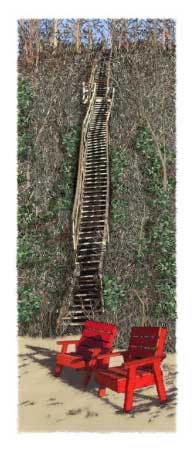
After my obsession with speed tiles, I got more conventional. I was fascinated by the stairways leading down to the beaches of Lake Michigan. There are tall sand dunes along the entire 300-plus miles of Lake Michigan’s Eastern shore where I live. People who live along the shore build stairways down to the beach. There are thousands of them and each one is different. So, I decided to do a series of pictures on these stairways.
A typical stairway picture started with a photograph. In Photoshop, I put a layer over the photo and using the photo as reference, made a line drawing of the stairway, Next, using colors, I dropped flat colors in between the black lines, cartoon style.
I later began drawing directly over the photo. And then I imported the whole thing into a paint program and began messing with the whole thing using palette knives and paint brushes.
My current series, the Urban Punk Series, is created using a variation of these techniques. I use lots of photographs, most of which I find online. I cut pieces out of them, and using layers in Photoshop, I create a montage of my composition. 50 or 60 pieces of cut out pictures are often used in this preliminary composition. I mess around with each layer, often distorting and resizing to make it fit with the other elements.
This is a common methodology used by many digital artists, but I like to take it a step further. I then take this montage into a paint program, currently using Artrage, and whack away at it with palette knives, paint brushes and all the other simulated tools in the program. I’m not crazy about the hard-edged look of photographic images, so I like to soften it up and mess it up a bit. I like it to look like a painting, not a photo.
Could you talk me through your thought process of producing new work and is the result how you first saw it?
Not sure where the initial ideas come from. Mostly from the odd juxtaposition of unrelated elements. I try to create a mystery, or an impossibility in the pictures. I hope they evoke a smile and make people think. Themes of this series are all related to environmental issues… each one offering a rather absurd solution to an environmental problem.
I have lots of pictures that I started, but gave up on. I’ve never made a picture that looks anything like what I had in mind when I started. The process of creating a picture changes the picture while I’m working on it.

What is your favored graphics software and how did you learn to use it?
I use Photoshop a lot to create the initial composition. I use Artrage to do the final rendering. I’m not a computer nerd. I’m a computer user. I’m not enamored by the infinite capabilities of computer software. In fact I’m intimidated by the increasing complexity. I use only what I need from a program, seldom venturing into unknown capabilities. I have two daughters who are expert graphic artists and they know lots more about how to do stuff with the computer than I do.
I learned a long time ago that an artistic tool has to be like an extension of the hand and brain. You can’t get all caught up with the technical aspects or the ideas and the spontanaity suffer. If I get all hung up on how to make some feature work with the software, that makes me a computer technician, not an artist. Some artists can do both, making the computer sing with all of its varied capabilities. I don’t. I wish I could, but I simply use the computer as a tool to make my pictures… using only the most elemental capabilities.
I remember learning this as a media producer. Many clients would choose a producer who had the latest technology rather than the producer who made the best programs. They think the guy with the latest bells and whistles would produce the best product. It continues to frustrate me. The end result is the important thing, not the technology that produces it.
What graphics tablet do you use?
I use an old Wacom tablet… the smallest model. I draw on the tablet with a stylus and the image appears on my iMac screen. I’m very interested in some day using a computer that lets me draw right on the screen. Some day I’ll get one. My daughter has one of the new iPads and she uses it for her comic blog thehillsite.com I tried it but wasn’t able to get the high resolution I needed.
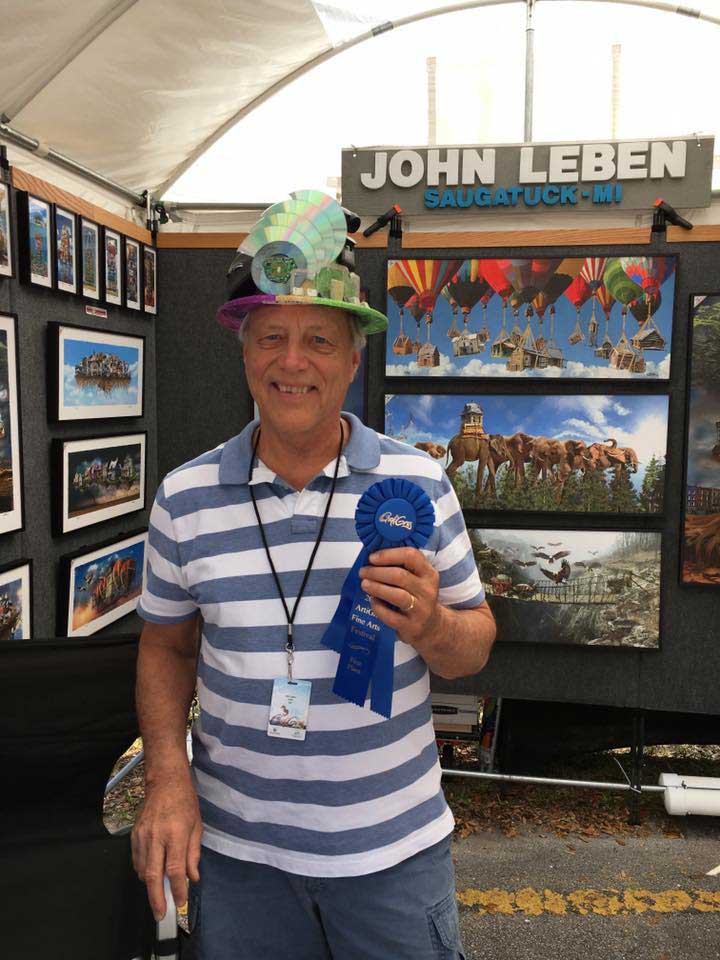
Here’s what I love about art fairs: I set up my exhibit. Put all my pictures on display, and people either like it or they don’t. No clients. If they like it enough they buy it. If they don’t they walk by. I don’t have to talk them into it. They either respond to the images or they don’t. It either means something to them, personally, or it doesn’t. I love that.
I’ve been exhibiting at art fairs for over 40 years. Mostly toying with them while making a living as a media producer, but pretty heavily over the past 15 years. Art fairs are physically demanding. Lots of work putting a booth together. You’re actually creating a gallery of your work on the street.
The materials needed to be an art fair artist can be expensive. I have a sturdy tent that cost about $2000, Wall panels that cost another $2000, a van for transporting my work that cost me $25,000, miscellaneous exhibition materials that run another couple thousand, and finally the artwork itself that is expensive for materials no matter what the medium. Typical cost of a good juried art fair is around $500 for renting the booth space, then there is lodging and meals in the city where the art fair is located.
Many artists (like me) start out with cheaper tents, panels and the like, transporting their work using their car or a rented trailer or van. So, it could be lots less of an investment to start out, but as an artist learns the ropes and starts to find some success, improvements can be purchased and added.
One word to describe the benefit of being an art fair artist: freedom!
I’m opening a gallery in my home town in May. I will still be exhibiting at art fairs for the near future because of the uncertainty of how successful the gallery will be. At a big art fair, I can show my work to 50,000 people or more over a weekend. At the gallery, I’ll obviously have less patrons.
Are you totally satisfied with the art that you produce?
I always like the last picture I did the best, but that doesn’t last long. Sometimes I wonder why anyone would buy my work at all. But, generally I am upbeat and happy with the work I’m currently doing. So far, I’ve never really finished a picture that I’m completely happy with. Maybe some day…
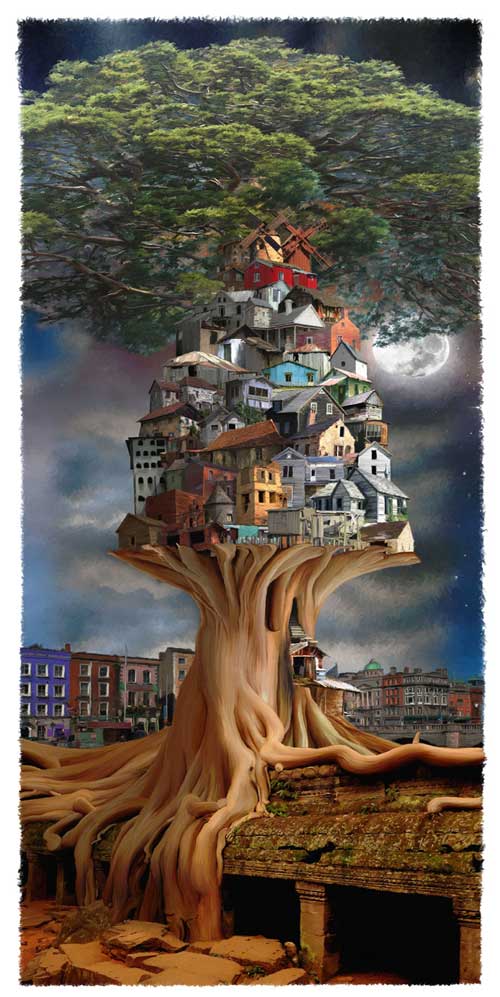
Which piece of art that you have produced has given you the most satisfaction and why?
“Moon Town” is one of my favorites. Its almost sold out in the editions I’m offering.
What advice would you give to someone who was thinking of moving from traditional to digital art?
The best digital artists are working in Hollywood, making movies. Or they are working in what has become an even bigger industry than movies, they are working on computer and video games. Incredible imagery in both of these areas.
As a fine artist using the computer as a printmaking tool, I feel like a complete hack compared to some of these guys and girls in Hollywood. I’m often inspired in my work by what I see at the movies and TV.
As a fine artist, there are lots of esoteric directions a digital artist can take. The simplest is using the computer as a medium for printmaking. That’s what I do. Its a way to spend a month developing an image just the way you want it, and then amortize the time and cost of that image over multiple editions. Its a good business plan for making a living as an artist… but only if you can develop images that other people can respond to positively.
Your art gallery opens in May 2017 – a fantastic achievement and you must be really excited and proud about this. How long has this been in the planning and how was the process of getting to this point?
The gallery has been in the planning stages for many years. As I get older, I find it more and more physically demanding to put up that tent and exhibit out on the street. Rewards can be many, but the uncertainties are also numerous and can be emotionally draining.
I’m hoping to eventually cut back on art fairs, doing only those that provide the most income. And I’m really excited about having a permanent home for my work, as well as providing a home to like-minded digital artists.
*You can find the LebenArt Gallery at 26 Center Street, Douglas, Michigan. The official opening of the LebenArt Gallery is Saturday May 6, 2017
Are there any areas in your skill as an artist that you would like to develop further?
Yes. I’ve been toying with exhibiting my digital art in its native format: a computer screen. And maybe adding motion to the image. Its tricky because that’s what a computer screen-saver is… an image that stays on the screen and sometimes has motion.
The motion would have to add a profound element to the piece, and the “monitor” it is displayed on would have to be transformed, somehow, from a TV or computer screen into an art piece.
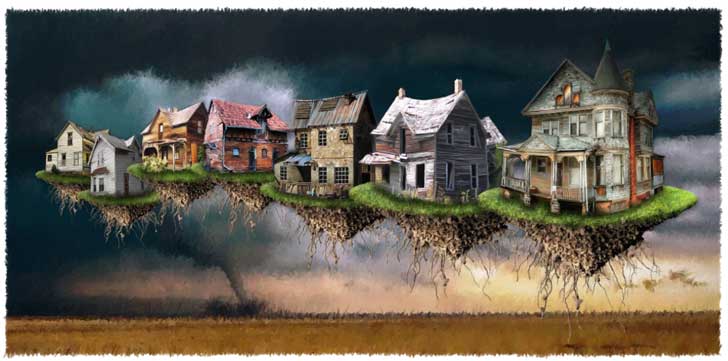
If you could jump in a time machine and went back to meet John Leben age 8 at the very beginning of his art career – what advice would you give him?
HA! I’ve actually thought about this a bit in the past. I’m making a good living selling my art right now. I wish I could have started earlier in this “fine art” career. I was always too busy making a living and raising my family.
Maybe if I was able to develop my talents faster, and find my audience earlier, I could have been making a living as an artist much sooner. But, I don’t have any regrets. My guess is that all the stuff I’ve done over the years has added to my knowledge and my sensibilities. If I hadn’t done all that other stuff, I probably wouldn’t be making the pictures I’m making now.
What have you got planned for the future?
I’m pretty focused on getting the gallery up and running right now. I’ve got two new digital paintings I’m working on and I’m also planning to resurrect some older digital work to exhibit in the gallery. I’m also looking forward to working with other digital artists in my gallery. Who knows. I might even learn something new.
And finally how can people find you if they want to see more of your work, commission a painting or buy your prints?
My website is best: LebenArt.com
The following video clip is a short documentary on John Leben
April 7th – 9th – Great Lakes Art Fair . Novi, MI
May 19th – 21st – Art Fair on the Square . Belleville, IL
June 2nd – 4th – Summerfair Cincinnati . Cincinnati, OH
June 9th – 11th – Columbus Art Festival . Columbus, OH
June 23rd – 25th – Des Moines Art Festival . Des Moines, IA
July 8th – 9th – Art Fair on the Square . Madison, WI
September 3rd – 4th – Art Fair on the Square . Lake Forest, IL
September 8th – 10th – St. Louis Art Fair St. Louis, MO
September 16th – 17th – Riverwalk Art Fair . Naperville, IL
September 22th – 24th – Plaza Art Fair . Kansas City, MO
October 6th – 8th – St James Court – 3rd Street – Louisville, KY
And don’t forget the official opening of the LebenArt Gallery on saturday 6th May 2017
If you are looking to get into digital art see my reviews of graphics tablets across a full range of size, price and design here…
